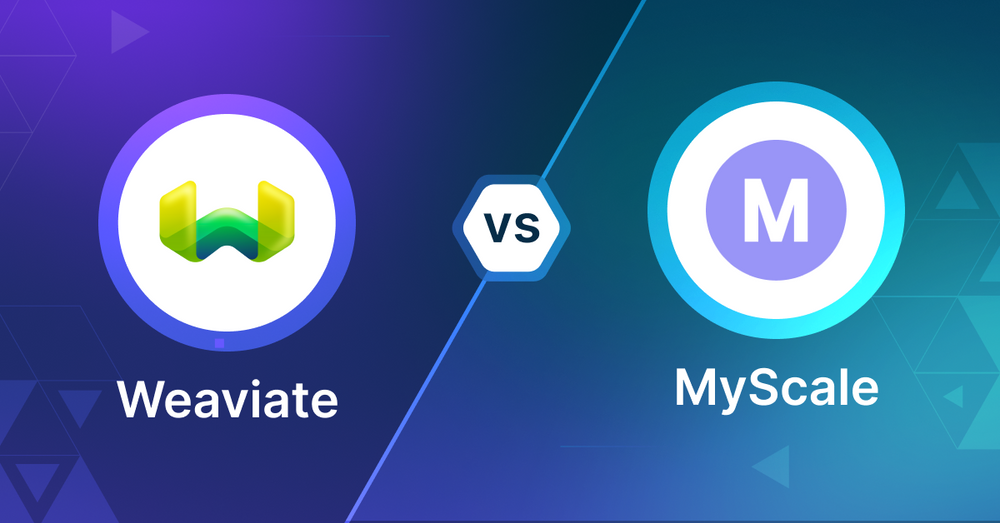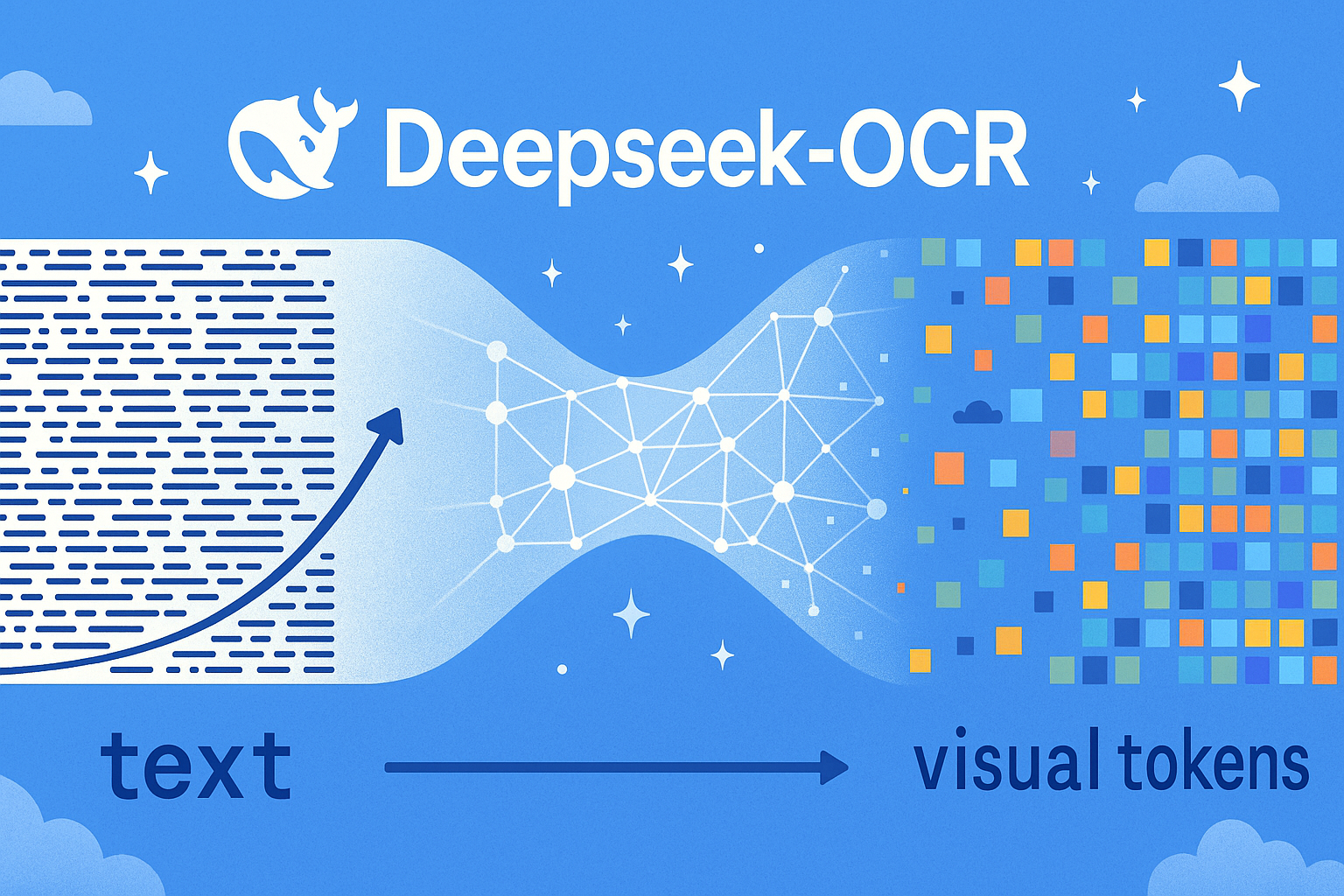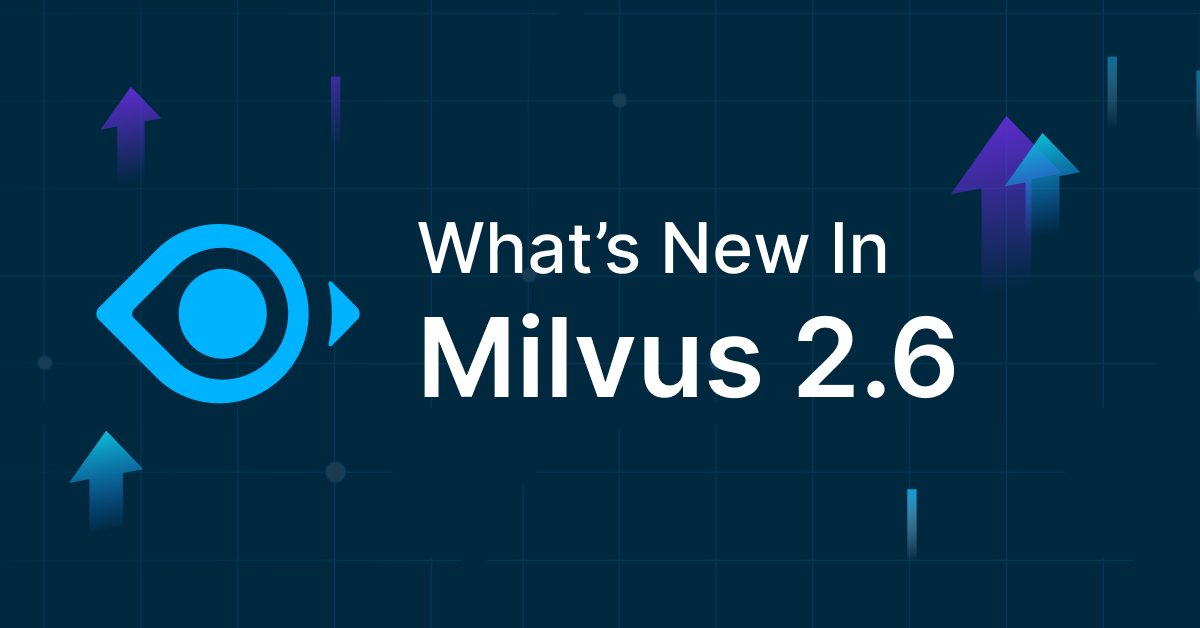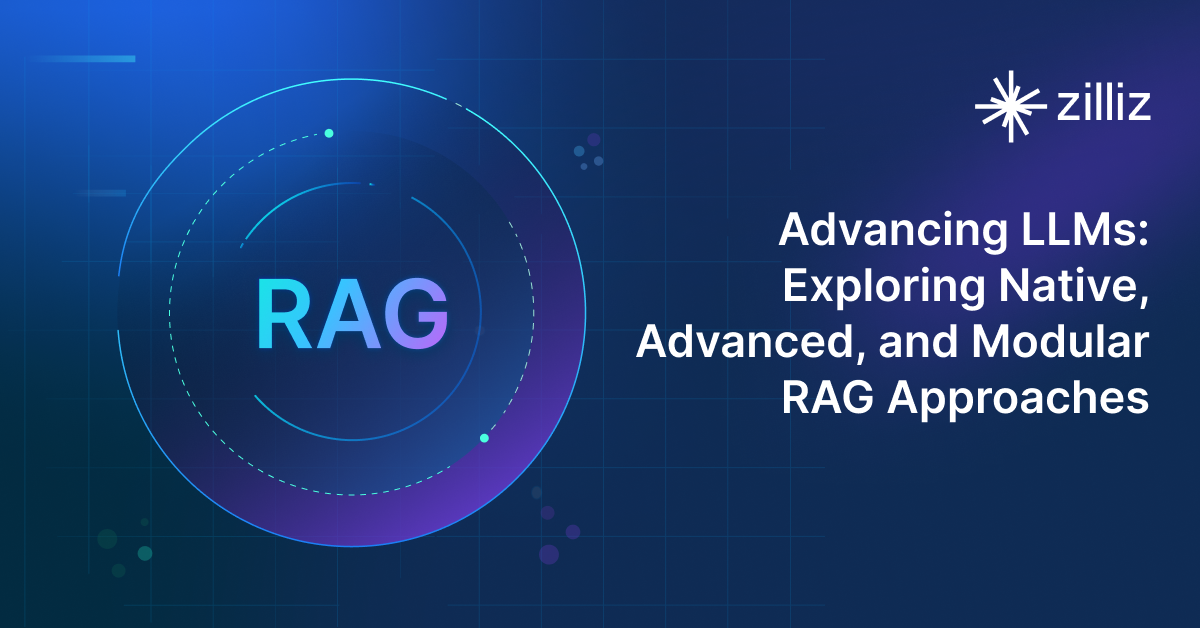Weaviate vs MyScale: Choosing the Right Vector Database for Your Needs

As AI and data-driven technologies advance, selecting an appropriate vector database for your application is becoming increasingly important. Weaviate and MyScale are two options in this space. This article compares these technologies to help you make an informed decision for your project.
What is a Vector Database?
Before we compare Weaviate and MyScale, let's first explore the concept of vector databases.
A vector database is specifically designed to store and query high-dimensional vectors, which are numerical representations of unstructured data. These vectors encode complex information, such as the semantic meaning of text, the visual features of images, or product attributes. By enabling efficient similarity searches, vector databases play a pivotal role in AI applications, allowing for more advanced data analysis and retrieval.
Common use cases for vector databases include e-commerce product recommendations, content discovery platforms, anomaly detection in cybersecurity, medical image analysis, and natural language processing (NLP) tasks. They also play a crucial role in Retrieval Augmented Generation (RAG), a technique that enhances the performance of large language models (LLMs) by providing external knowledge to reduce issues like AI hallucinations.
There are many types of vector databases available in the market, including:
- Purpose-built vector databases such as Milvus, Zilliz Cloud (fully managed Milvus), and Weaviate
- Vector search libraries such as Faiss and Annoy.
- Lightweight vector databases such as Chroma and Milvus Lite.
- Traditional databases with vector search add-ons capable of performing small-scale vector searches.
Weaviate is a purpose-built vector database and MyScale is a traditional database with vector search capabilities as an add-on. This post compares their vector search capabilities.
Weaviate: Overview and Core Technology
Weaviate is an open-source vector database designed to simplify AI application development. It offers built-in vector and hybrid search capabilities, easy integration with machine learning models, and a focus on data privacy. These features aim to help developers of various skill levels create, iterate, and scale AI applications more efficiently.
One of Weaviate's strengths is its fast and accurate similarity search. It uses HNSW (Hierarchical Navigable Small World) indexing to enable vector search on large datasets. Weaviate also supports combining vector searches with traditional filters, allowing for powerful hybrid queries that leverage both semantic similarity and specific data attributes.
Key features of Weaviate include:
- PQ compression for efficient storage and retrieval
- Hybrid search with an alpha parameter for tuning between BM25 and vector search
- Built-in plugins for embeddings and reranking, which ease development
Weaviate is an entry point for developers to try out vector search. It offers a developer-friendly approach with a simple setup and well-documented APIs. Deep integration with the GenAI ecosystem makes it suitable for small projects or proof-of-concept work. The target audience for Weaviate are software engineers building AI applications, data engineers working with large datasets and data scientists deploying machine learning models. Weaviate simplifies semantic search, recommendation systems, content classification and other AI features.
Weaviate is designed to scale horizontally so it can handle large datasets and high query loads by distributing data across multiple nodes in a cluster. It supports multi-modal data, works with various data types (text, images, audio, video) depending on the vectorization modules used. Weaviate provides both RESTful and GraphQL APIs for flexibility in how developers interact with the database.
However, for large-scale production environments, there are several considerations to keep in mind:
- Limited enterprise-grade security features
- Potential scalability challenges with multi-billion vector datasets
- Manual management required for newly released tiered storage options
- Horizontal scale-up requires assistance from Weaviate engineers and cannot be done automatically
This last point is particularly noteworthy, as it means organizations need to plan ahead and allocate time for scaling operations, ensuring they don't approach their system limits without proper preparation.
MyScale: Overview and Tech
MyScale is a cloud based database built on top of the open source ClickHouse database, designed for AI and machine learning workloads. It can handle structured and vector data and real time analytics and machine learning. MyScale is focused on time series, vector search and full text search so it’s good for real time processing and AI driven insights. By using ClickHouse architecture, MyScale is high performance and scalable for AI.
One of the key features of MyScale is native SQL support which simplifies AI driven queries by integrating vector search, full text search and traditional SQL queries in one system. This reduces the need for multiple tools and makes it scalable for AI. MyScale supports and manages analytical processing of both structured and vectorized data on one platform using OLAP database architecture to operate on vectorized data. Developers can interact with MyScale using SQL so it’s accessible to all programmers familiar with relational databases.
MyScale has multiple vector index types and similarity metrics to support different use cases. It supports common distance metrics like Euclidean distance (L2), inner product (IP) and cosine similarity. The database has multiple indexing algorithms: MSTG (Multi-Scale Tree Graph), ScaNN, IVFFLAT, IVFPQ, IVFSQ and HNSW, each with its own set of parameters to tune. MyScale’s proprietary MSTG vector engine uses NVMe SSDs to increase data density so it outperforms specialized vector databases in both performance and cost.
By combining the functionality of an SQL database, vector database and full text search engine into one system MyScale reduces infrastructure and maintenance costs. This unification allows for joint data queries and analytics and a single data foundation for AI applications. MyScale also has MyScale Telemetry for full observability of LLM systems so you can monitor and debug efficiently. As data gets more complex MyScale is a future proof solution that can handle newer data modalities and database sizes while keeping computing performance and integration between different data types.
Key Differences
When choosing a vector search tool, it’s important to understand the differences between Weaviate and MyScale. This comparison will help developers and engineers make an informed decision.
Search Methodology
Weaviate uses HNSW (Hierarchical Navigable Small World) indexing for fast and accurate similarity searches. It supports hybrid queries, combining vector searches with traditional filters. This allows for flexible searches on both semantic similarity and specific data attributes.
MyScale has multiple vector index types and similarity metrics. It has common distance metrics like Euclidean distance, inner product and cosine similarity. MyScale has multiple indexing algorithms: MSTG (Multi-Scale Tree Graph), ScaNN, IVFFLAT, IVFPQ, IVFSQ and HNSW. Each algorithm has tunable parameters, so you can customize it for your use case.
Data
Weaviate is good at handling structured and semi-structured data. It supports multi-modal data and can work with different data types: text, images, audio, video depending on the vectorization modules used.
MyScale is designed to handle both structured and vector data. It’s an SQL database, vector database and full-text search engine in one system. This unified approach allows for joint data queries and analytics and a single data foundation for AI applications.
Scalability and Performance
Weaviate is horizontally scalable, distributing data across multiple nodes in a cluster. But it may struggle with multi-billion vector datasets and horizontal scale-up requires Weaviate engineers’ help.
MyScale built on top of ClickHouse is designed for high performance and scalability. Its proprietary MSTG vector engine uses NVMe SSDs to increase data density and potentially outperforms specialized vector databases in both performance and cost. MyScale’s architecture can handle large datasets and high query loads.
Flexibility and Customization
Weaviate has flexibility through hybrid searches and multiple data types. It has both RESTful and GraphQL APIs so developers have options to interact with the database.
MyScale has native SQL support, vector search, full-text search and traditional SQL queries in one system. This simplifies queries and reduces the need for multiple tools. Developers can interact with MyScale using SQL so it’s familiar to programmers who know relational databases.
Integration and Ecosystem
Weaviate is part of the GenAI ecosystem and suitable for AI application development. It has built-in plugins for embeddings and reranking to simplify the development process.
MyScale focuses on integration between different data types within its own system. It has MyScale Telemetry for full observability of LLM systems so you can monitor and debug your AI applications.
Ease of Use
Weaviate is developer friendly, simple setup and well documented APIs. Good for smaller projects or PoC work.
MyScale’s SQL queries might be familiar to developers with SQL experience. But the many indexing algorithms and tuning options might require a bit more learning to optimize.
Cost
Both are open-source at the core but operational costs differ. Weaviate might have scalability issues with very large datasets and that can lead to higher costs in some cases. MyScale claims to reduce infrastructure and maintenance costs by having multiple database functionalities in one system.
Security Features
Weaviate has no enterprise grade security.
When to Choose Each
Weaviate is good for projects that need fast similarity searches and hybrid queries combining vector searches with filters. It’s great for AI applications that need fast setup and iteration, especially for semantic search, recommendation systems or content classification. Weaviate is good for multi-modal data (text, images, audio, video) and smaller projects or PoC in AI and machine learning. It’s developer friendly and part of the GenAI ecosystem so perfect for teams that want to add vector search without needing to be a database expert.
MyScale is good for projects that need a unified way to handle structured data, vector data and full-text search in one system. It’s great for applications that need real-time processing and AI driven insights from complex data. MyScale’s native SQL support makes it perfect for teams with SQL expertise so you can add vector search to your familiar query structures. Its scalability and performance features are especially good for large datasets so it’s great for enterprise level applications that need high performance analytics and machine learning workloads. MyScale is also good for projects that need full observability of LLM systems.
Conclusion
Weaviate is good for a user friendly approach to vector search with fast similarity searches, hybrid queries and easy integration with AI ecosystems. It’s great for multi-modal data and has a low barrier to entry. MyScale is good for unifying structured data, vector data and full-text search in one highly scalable system with a SQL interface and advanced performance features for complex enterprise level AI and analytics applications. When choosing between the two consider your use cases, data types and performance requirements. Weaviate might be good for teams that want quick implementation and flexibility with different data types, MyScale might be better for organisations that need a full SQL based solution for large scale data processing and AI driven analytics. Your decision should match your team’s expertise, the nature of your data and your long term scalability requirements.
While this article provides an overview of Weaviate and MyScale, it's key to evaluate these databases based on your specific use case. One tool that can assist in this process is VectorDBBench, an open-source benchmarking tool designed for comparing vector database performance. Ultimately, thorough benchmarking with specific datasets and query patterns will be essential in making an informed decision between these two powerful, yet distinct, approaches to vector search in distributed database systems.
Using Open-source VectorDBBench to Evaluate and Compare Vector Databases on Your Own
VectorDBBench is an open-source benchmarking tool designed for users who require high-performance data storage and retrieval systems, particularly vector databases. This tool allows users to test and compare the performance of different vector database systems such as Milvus and Zilliz Cloud (the managed Milvus) using their own datasets and determine the most suitable one for their use cases. Using VectorDBBench, users can make informed decisions based on the actual vector database performance rather than relying on marketing claims or anecdotal evidence.
VectorDBBench is written in Python and licensed under the MIT open-source license, meaning anyone can freely use, modify, and distribute it. The tool is actively maintained by a community of developers committed to improving its features and performance.
Download VectorDBBench from its GitHub repository to reproduce our benchmark results or obtain performance results on your own datasets.
Take a quick look at the performance of mainstream vector databases on the VectorDBBench Leaderboard.
Read the following blogs to learn more about vector database evaluation.
Further Resources about VectorDB, GenAI, and ML
- What is a Vector Database?
- Weaviate: Overview and Core Technology
- MyScale: Overview and Tech
- Key Differences
- When to Choose Each
- Conclusion
- Using Open-source VectorDBBench to Evaluate and Compare Vector Databases on Your Own
- Further Resources about VectorDB, GenAI, and ML
Content
Start Free, Scale Easily
Try the fully-managed vector database built for your GenAI applications.
Try Zilliz Cloud for FreeKeep Reading

DeepSeek-OCR Explained: Optical Compression for Scalable Long-Context and RAG Systems
Discover how DeepSeek-OCR uses visual tokens and Contexts Optical Compression to boost long-context LLM efficiency and reshape RAG performance.

Democratizing AI: Making Vector Search Powerful and Affordable
Zilliz democratizes AI vector search with Milvus 2.6 and Zilliz Cloud for powerful, affordable scalability, cutting costs in infrastructure, operations, and development.

Advancing LLMs: Exploring Native, Advanced, and Modular RAG Approaches
This post explores the key components of RAG, its evolution, technical implementation, evaluation methods, and potential for real-world applications.
The Definitive Guide to Choosing a Vector Database
Overwhelmed by all the options? Learn key features to look for & how to evaluate with your own data. Choose with confidence.